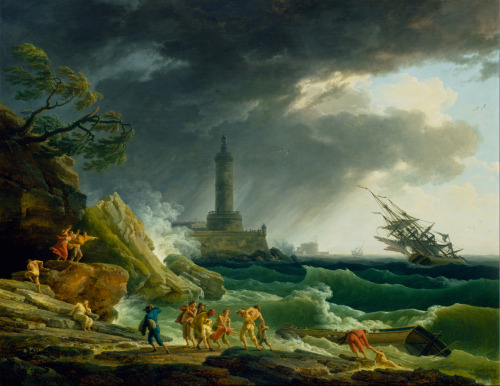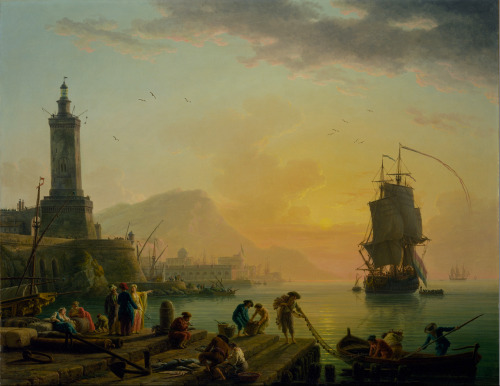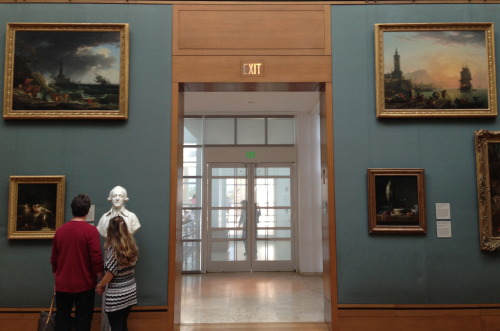I thought that “boat porn” image I reblogged earlier…
Wednesday, March 6th, 2013


I thought that “boat porn” image I reblogged earlier today looked familiar, and I was right: It’s a detail from a painting I admired at the Getty on my trip there a few weeks ago. It’s one of two paintings by Claude-Joseph Vernet hanging high on the wall in the same room, depicting what appears to be the same Mediterranean port, first in a storm, then in a calm.
From the Getty placards:
A Storm on a Mediterranean Coast (1767)
Claude-Joseph Vernet (French, 1714-1789)
Oil on canvas
The most famous landscape and marine painter of eighteenth-century France, Vernet excelled in the atmospheric depiction of imaginary Mediterranean locations. In A Storm, an English merchant vessel battles raging seas, while the exhausted, anguished survivors of a shipwreck are rescued. A diligent student of nature, Vernet rendered the elemental drama using a naturalistic palette dominated by greens, grays, and browns, applied in lively, sophisticated strokes. The companion to this picture, A Calm, hangs nearby.
A Calm at a Mediterranean Port (1770)
Claude-Joseph Vernet (French, 1714-1789)
Oil on canvas
Vernet described this painting as “a seaport enriched with many figures, edifices, and maritime buildings at sunset.” While Turkish merchants converse on the quay and fishermen pursue their daily activities, a Dutch warship is peacefully moored in the bay. Vernet’s balanced composition, warm palette, and controlled brushwork suggest a harmony between man and nature. Together, A Calm and A Storm — its companion hanging nearby — powerfully evoke stark contrasts of weather and its effects on mankind.
[me again]
As a sailor, I love the way Vernet captured the difference wind makes. In A Storm, the scene is loud and tumultuous; people are fighting for their lives. The British merchant ship is trying to claw its way off the lee shore, but is losing the battle, and those aboard know they don’t have much time. In my imagination the captain has ordered the women and children into a small boat with a few sailors to help them. It’s a desperate maneuver, but the captain believes it is their best chance of survival.
And it appears to have succeeded: The boat is being broken up by the waves, but its occupants have made it to land, with most of them apparently alive and well, save one woman being carried and one man still being helped from the water.
Higher on the shore, two survivors point to the stricken ship, heeling far over as it attempts to escape the rocks with its remaining skeleton crew. A ship like that in these conditions is probably making thirty degrees or more of leeway. Even if it successfully weathers the nearby lighthouse, it seems unlikely that it will be able to clear the more-distant headland. But if the wind moderates or veers, it may have a chance.
In A Calm, the same lighthouse looks out on a completely different scene. A gentle land breeze stirs the ship’s pennant as the Dutch naval vessel works its way into port, the sun setting behind. I grew up racing sailboats around the islands off Southern California, and I can’t count how many times I’ve sailed in conditions like this; the barest breath of wind ruffling the surface of the water, the crew concentrating on coaxing the sails to life. Cruising sailors fire up the engine when the wind dies, but racers (like their Age of Sail counterparts) don’t have that option. A large vessel sailing in light air is a wonderful thing, peaceful and majestic, and Vernet evokes that beautifully in A Calm.
I wish those two paintings had been displayed lower on the wall at the Getty; I wasn’t able to get as close as I wanted. The Getty website makes it easy to zoom in and see more details, which is great, but it doesn’t have the same emotional impact as standing in front of the original.
Reposted from http://lies.tumblr.com/post/44751877928.
